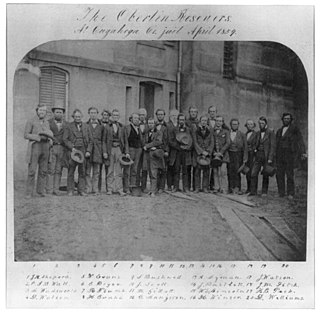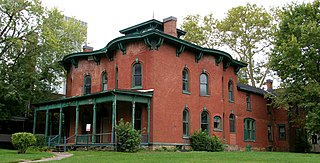
Eleutherian College, which was listed on the National Register of Historic Places in 1993 and declared a National Historic Landmark in 1997, was founded as Eleutherian Institute in 1848 by a group of local anti-slavery Baptists at Lancaster in Jefferson County. The institute's name comes from the Greek word eleutheros, meaning "freedom and equality." The school admitted students without regard to ethnicity or gender, including freed and fugitive slaves. Its first classes began offering secondary school instruction on November 27, 1848. The school was renamed Eleutherian College in 1854, when it began offering college-level coursework. It is the second college in the United States west of the Allegheny Mountains and the first in Indiana to provide interracial education. The restored three-story stone chapel and classroom building was constructed between 1853 and 1856 and presently serves as a local history museum.

John P. Parker was an American abolitionist, inventor, iron moulder and industrialist. Parker, who was African American, helped hundreds of slaves to freedom in the Underground Railroad resistance movement based in Ripley, Ohio. He saved and rescued fugitive slaves for nearly fifteen years. He was one of the few black people to patent an invention before 1900. His house in Ripley has been designated a National Historic Landmark and restored.
John Todd was an American Congregationalist minister, co-founder of Tabor College in Tabor, Iowa, a leading abolitionist and a conductor on the Underground Railroad.

The Oberlin–Wellington Rescue of 1858 in was a key event in the history of abolitionism in the United States. A cause celèbre and widely publicized, thanks in part to the new telegraph, it is one of the series of events leading up to Civil War.

Lewis Sheridan Leary was an African-American harnessmaker from Oberlin, Ohio, who joined John Brown's raid on Harpers Ferry, where he was killed.

John Anthony Copeland Jr. was born free in Raleigh, North Carolina, one of the eight children born to John Copeland Sr. and his wife Delilah Evans, free mulattos, who married in Raleigh in 1831. Delilah was born free, while John was manumitted in the will of his master. In 1843 the family moved north, to the abolitionist center of Oberlin, Ohio, where he later attended Oberlin College's preparatory division. He was a highly visible leader in the successful Oberlin-Wellington Rescue of 1858, for which he was indicted but not tried. Copeland joined John Brown's raid on Harpers Ferry; other than Brown himself, he was the only member of John Brown's raiders that was at all well known. He was captured, and a marshal from Ohio came to Charles Town to serve him with the indictment. He was indicted a second time, for murder and conspiracy to incite slaves to rebellion. He was found guilty and was hanged on December 16, 1859. There were 1,600 spectators. His family tried but failed to recover his body, which was taken by medical students for dissection, and the bones discarded.

The Coffin House is a National Historic Landmark located in the present-day town of Fountain City in Wayne County, Indiana. The two-story, eight room, brick home was constructed circa 1838–39 in the Federal style. The Coffin home became known as the "Grand Central Station" of the Underground Railroad because of its location where three of the escape routes to the North converged and the number of fleeing slaves who passed through it.

The Austin F. Williams Carriagehouse and House is a historic house at 127 Main Street in Farmington, Connecticut. Built in the mid-19th century, the property was designated a National Historic Landmark for the role it played in the celebrated case of the Amistad Africans, and as a "station" on the Underground Railroad.

The Owen Lovejoy House is a historic house museum on East Peru Street in Princeton, Illinois. Built in 1838, it was for many years home to Owen Lovejoy (1811-1864), a prominent abolitionist and congressman. Lovejoy, the brother of martyred abolitionist, Elijah Lovejoy, was an open operator of shelter and support on the Underground Railroad, and his house contains a concealed compartment in which escaped slaves could be hidden. It was declared a National Historic Landmark in 1997. It is open seasonally or by appointment for tours.

The F. Julius LeMoyne House is a historic house museum at 49 East Maiden Street in Washington, Pennsylvania. Built in 1812, it was the home of Dr. Francis Julius LeMoyne (1798–1897), an antislavery activist who used it as a stop on the Underground Railroad. LeMoyne also assisted in the education of freed slaves after the American Civil War, founding the historically black LeMoyne–Owen College in Memphis, Tennessee. His house, now operated as a museum by the local historical society, was designated a National Historic Landmark in 1997. It is designated as a historic public landmark by the Washington County History & Landmarks Foundation.

Rokeby Museum is a historic farm property and museum at 4334 United States Route 7 in Ferrisburgh, Vermont. The 90-acre (36 ha) property includes a 1780s farmstead, and eight agricultural outbuildings with permanent exhibits. Hiking trails cover more than 50 acres (20 ha) of the grounds. Rokeby is open from mid-May to mid-October each year. The property was designated a National Historic Landmark in 1997 for its association with Rowland T. Robinson, a Quaker and ardent abolitionist who openly sheltered escaped slaves at Rokeby as part of the Underground Railroad. Robinson's extensive correspondence is an essential archive giving insight into the practices of abolitionists and the operations of the railroad.

The Nathan and Mary (Polly) Johnson properties are a National Historic Landmark at 17–19 and 21 Seventh Street in New Bedford, Massachusetts. Originally the building consisted of two structures, one dating to the 1820s and an 1857 house joined with the older one shortly after construction. They have since been restored and now house the New Bedford Historical Society. The two properties are significant for their association with leading members of the abolitionist movement in Massachusetts, and as the only surviving residence in New Bedford of Frederick Douglass. Nathan and Polly Johnson were free African-Americans who are known to have sheltered escaped slaves using the Underground Railroad from 1822 on. Both were also successful in local business; Nathan as a caterer and Polly as a confectioner.

The John Mercer Langston House is a historic house at 207 East College Avenue in Oberlin, Ohio. Built in 1855, it was home to John Mercer Langston (1829-1897), attorney, abolitionist, diplomat, US Congressman and college president, who was one of the first African Americans elected to public office in the United States. It was designated a National Historic Landmark in 1975.

The Benjamin Lundy House is a historic house at Union and Market Streets in Mount Pleasant, Ohio. It was home in 1820 to abolitionist Benjamin Lundy (1789–1839), where he established the influential antislavery newspaper The Genius of Universal Emancipation, one of the first antislavery publications in the United States. It was designated a National Historic Landmark in May 1974, and included in the Mount Pleasant Historic District later the same year.

The John P. Parker House is a historic house museum at 300 North Front Street in Ripley, Ohio. It was home to former slave and inventor John P. Parker (1827–1900) from 1853 to his death in 1900. Parker was an abolitionist and a well-documented conductor on the Underground Railroad, helping hundreds of escaped slaves. The house was listed on the National Register of Historic Places in 1980, and it was further designated a National Historic Landmark in 1997. It is now owned and managed by a local nonprofit organization as a museum about Parker's life and the abolitionist movement.

The John Rankin House is a historic house museum at 6152 Rankin Hill Road in Ripley, Ohio. Built in 1828, it was home to Presbyterian abolitionist John Rankin, and was one of the original stops on the Underground Railroad. Harriet Beecher Stowe's visit to Rankin provided some of the story that became Uncle Tom's Cabin. The house was acquired by the State of Ohio in 1938 and is now operated by the Ohio History Connection and opened for tours. It was designated a National Historic Landmark in 1997.

The James and Sophia Clemens Farmstead is a historic farm situated in western Darke County, Ohio, United States. Located at 467 Stingley Road, approximately 1 mile (1.6 km) from the Indiana border, it is among the oldest remaining buildings of a small community of free African-Americans founded before the Civil War.

White Horse Farm, also known as the Elijah F. Pennypacker House, is a historic home and farm located in Schuylkill Township, Chester County, Pennsylvania. The original section was built around 1770. In the 19th century, it was the home of abolitionist Elijah F. Pennypacker and served as a station on the Underground Railroad. The farm was added to the National Register of Historic Places in 1987.

Cozad–Bates House, also known as the Cozad–Bates House Interpretive Center, is the oldest and only surviving pre-Civil War structure in University Circle, Cleveland, Ohio, located at the Mayfield Road and East 115th Street intersection. It is historically known for its involvement in the Underground Railroad. Abolitionist Andrew Cozad built the house in 1853 for his son Justus L. Cozad, who in 1872 added an Italianate front to the structure. Architecturally, it is a rare surviving example of Italianate-influenced residential architecture in America at that time, which includes a hipped roof, curved bay windows, paired eave brackets, and prominent belvedere. The house was listed on the National Register of Historic Places in 1974 and designated as a Cleveland Landmark in 2006.



















